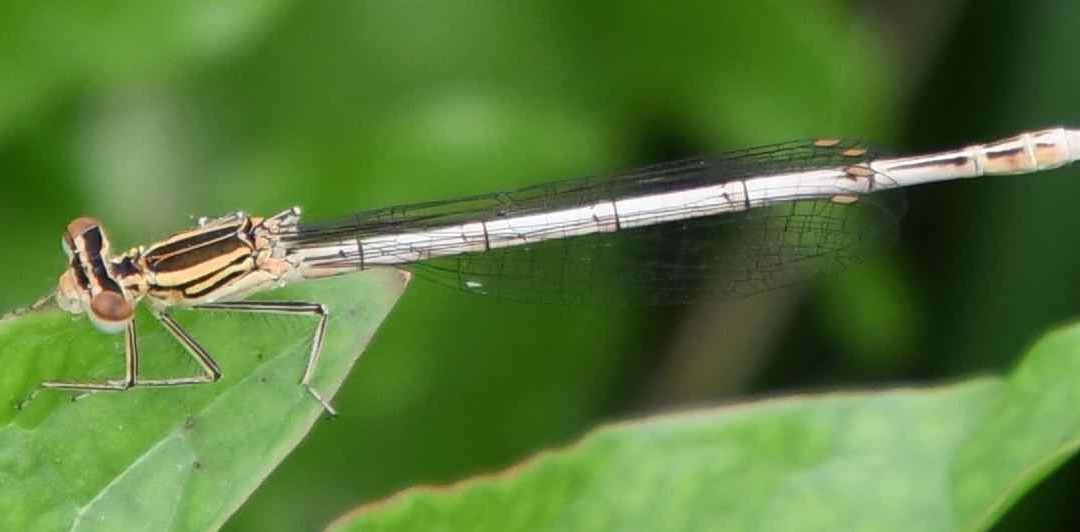Contribute to the BathNats Lockdown Log for July
While field trips are suspended do share any sightings of interest within the BathNats area. Use the contact form and if you have any photos to share ask on the form for a direct email link to submit them. And don’t miss our lockdown log for tMarch to May and June.
Main photo: White legged damselfly female 6 July 2020 by John Rawles.
Lucy Starling reports: On 6 July, with two Nats members, we walked via the canal towpath to Bathampton Farm field and the banks of the River Avon below Bathford, returning to Bathwick via fields leading to Grosvenor Bridge.

Blue tailed damselfly, 6 July 2020 © John Rawles

Essex Skippers mating 6 July 2020 © John Rawles
On a mainly cloudy and windy morning, we did well finding Essex Skippers (my first of 2020) and Roesel’s Bush Cricket (I have yet to find a Dark Bush Cricket)! No large dragonflies seen but we found several White-legged damselflies and a Blue-tailed damselfly.
Lots of Meadowsweet along the banks of the canal and some Purple Loosestrife. The adult Mute Swans are still very protective of their cygnets!

Roesel’s Bush Cricket Bathampton Farm field © John Rawles

Roesel’s Bush Cricket Bathampton Farm field © John Rawles

Purple Loosestrife 6 July 2020 © John Rawles
Alice Nissen reports from 2 July: A circular walk via Batheaston & Bathampton meadows took us past a muddy bank near Bathampton church and 3 beautiful spikes of ivy broomrape, which I’m told is very uncommon in the area.

Ivy broomrape © Alice Nissen

Juvenile chiffchaff © Alice Nissen

Scarlet tiger © Alice Nissen
Alice Nissen photographed a couple of interesting visitors to her Bath garden:
A Scarlet Tiger raked from our almost waist-high lawn, and a young chiffchaff that has taken to joining the tits, robin and even a pair of nuthatches with a young one at our bird feeder. It stays for several minutes and sits looking bemused as others swirl around it.
Warm weather on 11 July brought out butterflies in abundance. In a single walk along St Catherine’s Brook, over Charmy Down and into Chilcott Bottom David Hall recorded a dozen species.

Small Heath 11 July 2020 © David Hall

Meadow Brown, 11 July 2020, © David Hall

Peacock, 11 July 2020, © David Hall

Ringlet, 11 July 2020, © David Hall

Green-veined White, 11 July 2020, © David Hall

Marbled White, 11 July 2020, © David Hall

Gatekeeper, 11 July 2020, © David Hall

Small Tortoiseshell, 11 July 2020, © David Hall

Silver-washed Fritillary, 11 July 2020, © David Hall

Red Admiral, 11 July 2020, © David Hall

Speckled Wood, 11 July 2020, © David Hall

Comma, 11 July 2020, © David Hall
Alice Nissen reports : At 11 pm on July 10, while searching for the Neowise comet from the Langridge road, we watched a barn owl – latterly in silhouette – quartering a field nearby.
Lucy Starling reports on 21 July: I walked the Batheaston – Bath riverside circuit with another Bath Natural History Society member on a glorious sunny and warm morning.
The dragonfly “hot spot” along the Avon below Batheaston did not disappoint. A few White-legged and Blue-tailed damsels and female Banded Demoiselles but best of all, 5 Brown Hawkers hunting low over the nettles. As ever, none settled to be photographed. We found a Small Copper butterfly on the edge of Bathampton Farm field, only my second for the year. Lots of fresh looking Comma butterflies.
It was like June rewind back at the wet ditch near Grosvenor! After weeks of silence and no birds to be seen, after glimpsing one of the adult Sedge Warblers last Thursday, I saw both adults. They were flying quite regularly in and out of the thorny rose bush area. And, for about a minute, one bird popped up in the open as if keeping watch and stayed there for at about a minute. They seemed to be hunting for food in the adjacent hedgerow, flying towards the top, working their way back down and then flying low along the ditch back to the thorny bush. So, am now back on more regular watch duty!
To top off a splendid morning, as I walked into my garden off Forester Road, a bright insect displaying a lot of red/orange flew past my face and landed in the beech hedge. It was a Jersey Tiger moth. I had noted an email from the moth group that one had been trapped in Keynsham. I then had another sighting of a Jersey Tiger near Henrietta Park at about 1.30pm.
I managed to get a photograph of the moth on the beech hedge using my iPad. So happy!!!

Jersey Tiger, Bath © Lucy Starling

Ivy Broomrape, Tyning Road, Bathampton © Lis Allen

Giant Hogweed © Lis Allen
Paul Wilkins of BathNats Moth Group confirms that there have been quite a few Jersey Tiger moths seen in the week up to 22 July in the Bath area. Geoff Hiscocks photographed one in his garden. Several other BathNats Moth Group members have also reported them.
Paul explains that the Jersey Tiger moth was once considered a rare (Nationally Scare B) moth in Britain before the 1990s and a suspected immigrant, but in recent years it has been expanding its range northwards from resident colonies along the south coast and has been seen in increasing numbers in the Bath area.
They are often active during the day when they are often seen, but they are also attracted to light. Their caterpillars feed on a number of herbaceous plants but particularly Common Nettle and Hemp-agrimony.

Jersey Tiger, Oldfield Park, 22 July 2020 © Geoff Hiscocks
Paul came across these Parent Bugs (Elasmucha grisea) on a Silver Birch in Combe Down.

Parent Bugs (Elasmucha grisea), 23 July 2020 © Paul Wilkins


Recent Comments